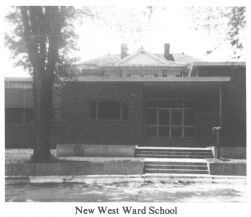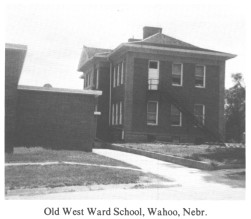 |
STOCKING PRECINCT |
 |
STOCKING PRECINCT |
|
Through all of these years the school struggled for money. The church supported them and so did many individuals, but it would never have continued for the seventy nine years if it hadn't been for the many, many fine and dedicated teachers who gave their all to the preservation of the school. The real history of Luther is written in the lives of those who came as students and then left as dedicated Christians to work in all walks of life. In 1959, the last Senior Academy class graduated and that department was dropped. In 1962, the Lutheran Church of America was formed and as a result Luther merged with Midland College in Fremont and the campus was closed. JOHN F. KENNEDY COLLEGEJohn F. Kennedy College was a non-sectarian, co-educational, private and independent college which, in April 1965, was named for the 35th President of the United States. Housed in the facilities of the 75-year-old Luther Junior College, John F. Kennedy College was born in the fall of 1965. The campus of approximately thirty acres covers the highest point of the city and is plentifully graced with flowering and non-flowering trees and shrubs. The buildings are located on the outer edges of the campus leaving a park like atmosphere in the center. Raymond Greenhalgh, the first president, and a group of devoted townspeople serving on the first board of trustees held firmly to the belief that higher education must be based upon individual attention. At the start, 182 students enrolled. They came from 16 states, and the District of Columbia, and the next year the enrollment was up -- way up. With a student-faculty ratio of twenty to one, the student was in constant contact and direct communication with the professor in both the classroom and the informal gathering experience. In the third year, Ted Dillow, who became the President, immediately informed the college staff, faculty, and community that the college was already in severe financial straits, and that he would be seeking additional trustees from outside the local area, which he did. Even though the financial plight continued the college went on to gain national acclaim primarily through its women's sports programs. In 1970, the JFK Patriettes went to the finals of the National Amateur Athletic Union basketball playoffs. Two years later, they won the championship. The next year they were asked to participate in a State Department cultural exchange tour of Mainland China. The college also hosted two international invitational tournaments in Omaha with teams representing Mexico, Canada, and the Republic of China (Taiwan). JFK girls' softball teams won the Women's Softball College World Series in 1969, 1970, and 1971. Unfortunately, to balance the good years, there were also major disappointments. Fires in 1971 destroyed two major buildings -- the faculty office and cafeteria building and Old Main housing the administrative offices, classrooms, the chapel-theatre and the library. The college was scissored by increasing costs and declining enrollment. Faculty and staff continued without salary for months at a time at several different intervals; they continued to hold on because they believed in what they were doing. Then in July, 1975, when hope of financial recovery was impossible, the trustees voted to close the college and file for bankruptcy. There is no monument to those who founded JFK or to those who struggled to keep it alive and productive, but the graduates, faculty, staff, trustees and friends of the college can look back and know, that because of their high hopes and dedication, many of their worthwhile endeavors were accomplished. Submitted by Connie Dillow
CAMEL CENTERThe revival of Wahoo's old college campus as a treatment center for alcohol/drug abusers began in early 1983. The centennial observance of the campus will be combined with a grand opening for CAMEL CENTER INC. Along with outpatient treatment, counseling services and intervention, the privately owned thirty-day residential facility is expected to attract clientele from Nebraska and surrounding states. The fees are very competitive to other centers, and are much lower than hospital-sponsored programs. Treatment techniques include the philosophy of Alcoholic Anonymous, problem recognition, a behavior change process, a concepts workshop and rational /emotive self-help techniques -- all of which teach the clients how to enjoy an alcohol/ drug free lifestyle. Family participation/counseling is highly encouraged. Camel Center is staffed with experienced counselors and excellent supporting personnel, many who reside in the Wahoo area.
WAHOO PUBLIC SCHOOL |
 |
| New West Ward School |
 |
| Old West Ward School, Wahoo, Nebr. |
In the spring of 1954, the taxpayers voted $243,000 in bonds to erect the new West Ward building and to build additions to the North Ward and the High School. The West Ward building cost approximately $175,000. The equipment for the building was purchased through a Federal grant allotted to the district because of the number of Ordnance Plant children being educated by the district.
On the site of the present Civic Center there was a one-room school which began at about the same time as West Ward. This was known as Central and remained until 1948 when it was cleared away to make room for the present gymnasium.
The first High School was a two-story frame building with three rooms on the first floor and three on the second. The story is told of Supreme Court Judge Reese, who in the early eighties was attending
page 141
| Back | Contents | Next |